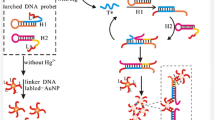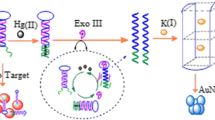Abstract
The authors describe a method for detection of Hg2+ by using positively charged gold nanoparticles ((+)AuNPs) as a quencher of the fluorescence of DNA-capped silver nanoclusters (DNA-AgNCs) which are negatively charged. In the presence of Hg2+, a DNA duplex is formed through T-Hg2+-T coordination chemistry. The duplex can be digested by exonuclease III to form smaller DNA fragments. This leads to the release of the AgNCs and the recovery of fluorescence, best measured at excitation/emission wavelengths of 460/530 nm. The (+)AuNPs and Hg2+ are also released and can be reused for target recycling signal amplification. Based on these findings, a method is worked out for the determination of Hg2+ that works in the 5.0 pM to 10 nM concentration range and has a detection limit as low as 2.3 pM. It is highly selective because of the highly specific formation of T-Hg2+-T bonds.

By using ultrastable and positively charged gold nanoparticles as fluorescence quenchers and exonuclease assisted signal amplification, a method is developed for the sensitive and selective detection of Hg2+ in water samples.



Similar content being viewed by others
References
Ma DL, Lin S, Wang W, Yang C, Leung CH (2017) Luminescent chemosensors by using cyclometalated iridium (III) complexes and their applications. Chem Sci 8(2):878–889
Kim TI, Hwang B, Lee B, Bae J, Kim Y (2018) Selective monitoring and imaging of eosinophil peroxidase activity with a J-aggregating probe. J Am Chem Soc 140(37):11771–11776
Sedgwick AC, Dou WT, Jiao JB, Wu L, Williams GT, Sessler JL, James TD (2018) An ESIPT Probe for the Ratiometric Imaging of Peroxynitrite Facilitated by Binding to Aβ-Aggregates. J Am Chem Soc 140(43):14267–14271
Vellaisamy K, Li G, Ko CN, Zhong HJ, Fatima S, Kwan HY, Wong CY (2018) Cell imaging of dopamine receptor using agonist labeling iridium (III) complex. Chem Sci 9(5):1119–1125
Wu C, Wu KJ, Kang TS, Wang HMD, Leung CH, Liu JB, Ma DL (2018) Iridium-based probe for luminescent nitric oxide monitoring in live cells. Sci Rep 8:12467
Wang W, Wu C, Yang C, Li G, Han QB, Li S, Ma DL (2018) A dual-functional luminescent probe for imaging H2S in living zebrafish and discrimination hypoxic cells from normoxic cells. Sensor Actuators B Chem 255:1953–1959
Zang J, Li C, Zhou K, Dong H, Chen B, Wang F, Zhao G (2016) Nanomolar Hg2+ detection using β-Lactoglobulin-stabilized fluorescent gold nanoclusters in beverage and biological media. Anal Chem 88(20):10275–10283
Xu S, Liu Y, Yang H, Zhao K, Li J, Deng A (2017) Fluorescent nitrogen and sulfur co-doped carbon dots from casein and their applications for sensitive detection of Hg2+and biothiols and cellular imaging. Anal Chim Acta 964:150–160
Furletov AA, Apyari VV, Garshev AV, Dmitrienko SG, Zolotov YA (2017) Triangular silver nanoplates as a spectrophotometric reagent for the determination of mercury (II). J Anal Chem 72(12):1203–1207
Zu F, Yan F, Bai Z, Xu J, Wang Y, Huang Y, Zhou X (2017) The quenching of the fluorescence of carbon dots: a review on mechanisms and applications. Microchim Acta 184(7):1899–1914
Hou T, Li W, Liu X, Li F (2015) Label-free and enzyme-free homogeneous electrochemical biosensing strategy based on hybridization chain reaction: a facile, sensitive, and highly specific MicroRNA assay. Anal Chem 87(22):11368–11374
Chen T, Tan S, Li W, Zhu Y (2017) Amplified fluorescent detection of mercuric ions by conjugation of the ThT-induced G-Quadruplex based hybridization chain reaction. Anal Sci 33(12):1333–1337
Chen J, Tong P, Lin Y, Lu W, He Y, Lu M, Zhang L, Chen G (2015) Highly sensitive fluorescent sensor for mercury based on hyperbranched rolling circle amplification. Analyst 140(3):907–911
Ma J, Chen Y, Hou Z, Jiang W, Wang L (2013) Cascade signal amplification based on copper nanoparticle-reported rolling circle AmY. Chen, Z. Hou, W. Jiang and L. Wang, selective and sensitive mercuric (ii) ion detection based on quantum dots and nicking endonuclease assisted signal amplification. Biosens Bioelectron 43(4):84–87
Wang G, Xu G, Zhu Y, Zhang X (2013) A "turn-on" carbon nanotube-Ag nanoclusters fluorescent sensor for sensitive and selective detection of Hg2+with cyclic amplification of exonuclease III activity. Chem Commun 50(6):747–750
Kong RM, Song ZL, Meng HM, Zhang XB, Shen GL, Yu RQ (2014) A label-free electrochemical biosensor for highly sensitive and selective detection of DNA Via a dual-amplified strategy. Biosens Bioelectron 54:442–447
Hu P, Zhu C, Jin L, Dong S (2012) An ultrasensitive fluorescent aptasensor for adenosine detection based on exonuclease III assisted signal amplification. Biosens Bioelectron 34(1):83–87
Wang W, Bao T, Zeng X, Xiong H, Wen W, Zhang X, Wang S (2017) Ultrasensitive electrochemical DNA biosensor based on functionalized gold clusters/graphene nanohybrids coupling with exonuclease III-aided cascade target recycling. Biosens Bioelectron 91:183–189
Zarlaida F, Adlim M (2017) Gold and silver nanoparticles and indicator dyes as active agents in colorimetric spot and strip tests for mercury (II) ions: a review. Microchim Acta 184(1):45–58
Apyari VV, Arkhipova VV, Dmitrienko SG, Zolotov YA (2014) Using gold nanoparticles in spectrophotometry. J Anal Chem 69(1):1–11
Wang W, Kong T, Zhang D, Zhang J, Cheng G (2015) Label-free MicroRNA detection based on fluorescence quenching of gold nanoparticles with a competitive hybridization. Anal Chem 87(21):10822–10829
Qian R, Ding L, Yan L, Lin M, Ju H (2014) A robust probe for lighting up intracellular telomerase via primer extension to open a nicked molecular beaco. J Am Chem Soc 136(23):8205–8028
Wu P, Hwang K, Lan T, Lu Y (2013) A DNAzyme-gold nanoparticle probe for uranyl ion in living cells. J Am Chem Soc 135(14):5254–5257
Ma H, Xue N, Li Z, Xing K, Miao X (2018) Ultrasensitive detection of miRNA-155 using multi-walled carbon nanotube-gold nanocomposites as a novel fluorescence quenching platform. Sensor Actuators B Chem 266:221–227
Miao X, Cheng Z, Ma H, Li Z, Xue N, Wang P (2017) Label-free platform for microRNA detection based on the fluorescence quenching of positively charged gold nanoparticles to silver nanoclusters. Anal Chem 90(2):1098–1103
Xie H, Dong J, Duan J, Waterhouse GI, Hou J, Ai S (2018) Visual and ratiometric fluorescence detection of Hg2+ based on a dual-emission carbon dots-gold nanoclusters nanohybrid. Sensor Actuators B Chem 259:1082–1089
Gao ZH, Lin ZZ, Chen XM, Lai ZZ, Huang ZY (2016) Carbon dots-based fluorescent probe for trace Hg2+ detection in water sample. Sensor Actuators B Chem 222:965–971
Yun W, Xiong W, Wu H, Fu M, Huang Y, Liu X, Yang L (2017) Graphene oxide-based fluorescent “turn-on” strategy for Hg2+ detection by using catalytic hairpin assembly foramplification. Sensor Actuators B Chem 249:493–498
Huang D, Niu C, Wang X, Lv X, Zeng G (2013) “Turn-on” fluorescent sensor for Hg2+ based on single-stranded DNA functionalized Mn:CdS/ZnS quantum dots and gold nanoparticles by time-gated mode. Anal Chem 85:1164–1170
Deng L, Ouyang X, Jin J, Ma C, Jiang Y, Zheng J, Li J, Li Y, Tan W, Yang R (2013) Exploiting the higher specificity of silver amalgamation: selective detection of mercury(II) by forming Ag/Hg amalgam. Anal Chem 85:8594–8600
Bian RX, Wu XT, Chai F, Li L, Zhang LY, Wang TT, Wang CG, Su ZM (2017) Facile preparation of fluorescent Au nanoclusters-based test papers for recyclable detection of Hg2+ and Pb2+. Sensor Actuators B Chem 241:592–600
Yu L, Lan W, Xu H, Chen H, Bai L, Wang W (2017) Label-free detection of Hg2+ based on -triggered toehold binding, exonuclease III assisted target recycling and hybridization chain reaction. Sensor Actuators B Chem 248:411–418
Hong M, Zeng B, Li M, Xu X, Chen G (2018) An ultrasensitive conformation-dependent colorimetric probe for the detection of mercury (II) using exonuclease III-assisted target recycling and gold nanoparticles. Microchim Acta 185(1):72
Acknowledgements
This work was supported by the National Natural Science Foundation of China (No. 21305053), the Natural Science Foundation of Xuzhou City (KC18140), and the project funded by the Priority Academic Program Development of Jiangsu Higher Education Institutions (PAPD).
Author information
Authors and Affiliations
Corresponding authors
Ethics declarations
The author(s) declare that they have no competing interests.
Additional information
Publisher’s note
Springer Nature remains neutral with regard to jurisdictional claims in published maps and institutional affiliations.
Electronic supplementary material
ESM 1
(DOCX 340 kb)
Rights and permissions
About this article
Cite this article
Ma, H., Xue, N., Wu, S. et al. Fluorometric determination of mercury(II) using positively charged gold nanoparticles, DNA-templated silver nanoclusters, T-Hg(II)-T interaction and exonuclease assisted signal amplification. Microchim Acta 186, 317 (2019). https://doi.org/10.1007/s00604-019-3388-7
Received:
Accepted:
Published:
DOI: https://doi.org/10.1007/s00604-019-3388-7




